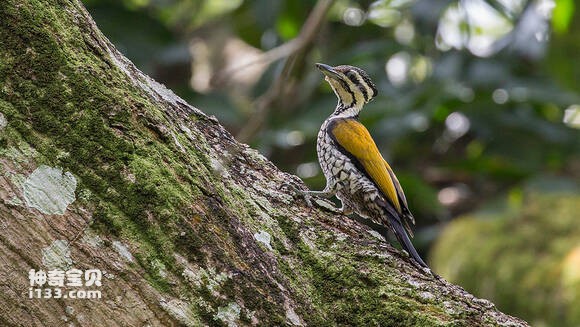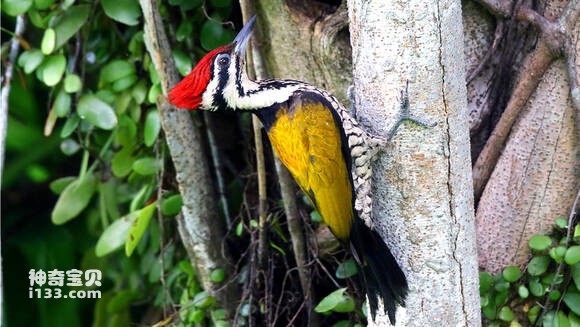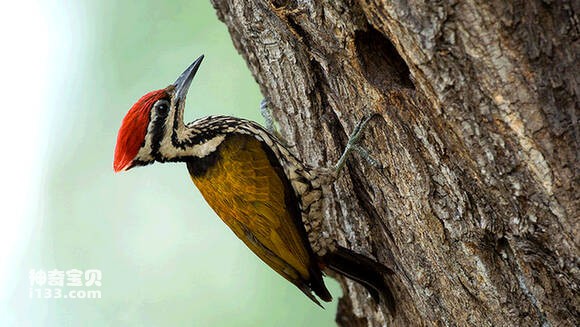Dinopium javanense
IUCN
LCBasic Information
Scientific classification
- name:Dinopium javanense
- Scientific Name:Dinopium javanense,Common Flameback
- Outline:Climbing birds
- Family:
Vital signs
- length:28-30cm
- Weight:57-100g
- lifetime:No textual research information is available
Feature
Distribution and Habitat
The species is found in Bangladesh, Brunei Darussalam, Cambodia, India, Indonesia, Lao People's Democratic Republic, Malaysia, Myanmar, Philippines, Singapore, Thailand, and Vietnam. Xishuangbanna, southern Yunnan, China.
The golden-backed three-toed woodpecker intakes in secondary forests, sparse woodlands, deciduous shrub lands, and mangroves, as well as teak forests and high elevation pine forests. Especially enjoy coconut plantations, arable land, gardens, parks and golf courses. It is distributed at different altitudes from low to medium. They can be seen at an altitude of 1000 meters in the Greater Sunda Islands, up to 1500 meters in Southeast Asia, and even up to 1700 meters in India.
Appearance
The golden-backed three-toed woodpecker is a medium sized, brightly colored woodpecker with a body length of 28-30 cm and a weight of 57-100 g. The forehead, head, pillow and crown are black, the face has black and white stripes, the back is golden yellow with orange, and the waist is bright red. The male is red on the crown and crest; The forehead, head, pillow and crown are black, the back is golden yellow with orange, and the waist is bright red. The feet have only three toes. The forehead, head, pillow and crown of the female adult bird are black, and the inner feathers of each feather are white. There is a thick white stripe on the eyes and under the eyes to the neck; There is also a thick black stripe behind the eyes to the neck; Under the white stripe there is a thick black stripe; Back golden yellow, rendering orange-red; Waist bright red; Black tail feathers; The outer feathers of the secondary feathers are greenish gold, and the cover feathers are greenish gold, as are the ou
Details
The golden-backed three-toed woodpecker is known by its scientific name Dinopium javanense and foreign name Common Flameback, with six subspecies.

Golden-backed three-toed woodpeckers often move alone or in pairs and call each other frequently. More activities and foraging on tree trunks and branches, but also to the ground on the activity and foraging on trees. Flying in a wavy pattern, often cries while flying. It feeds mainly on insects and invertebrates, including ants, insect larvae, small scorpions, cockroaches and woodbores, among other species. Calls: The gruff, drawn-out trills of "churrrr" and "chee chee" are made between spouses, and the blunt "kluuk, kluuk, kluuk" is made during flight。

The spawning season varies from region to region, from February to April in India, from June in Thailand, from January to July in Peninsular Malaysia, and from April, May, July, November and December in Borneo. Nest in the tree hole, the nest hole is mostly chosen in the open forest live tree or dead tree trunk, by the parent bird to peck the hole, the hole is different from the ground height, from 2 to 10 meters. It is usually placed under an old tree stump, 5 meters off the ground. Fruit trees or palm trees are the most common situation. Two to three eggs are laid per litter, sometimes only one. Oval white in size 27-31 x 18-23 mm。

It was included in the List of Beneficial Terrestrial Wildlife under State Protection or of Important economic and scientific research Value issued by the State Forestry Administration of China on August 1, 2000.
Listed on the International Union for Conservation of Nature (IUCN) 2012 Red List of Threatened Species ver 3.1 - Low Risk (LC).
Protect wild animals and eliminate wild meat.
Maintaining ecological balance is everyone's responsibility!








